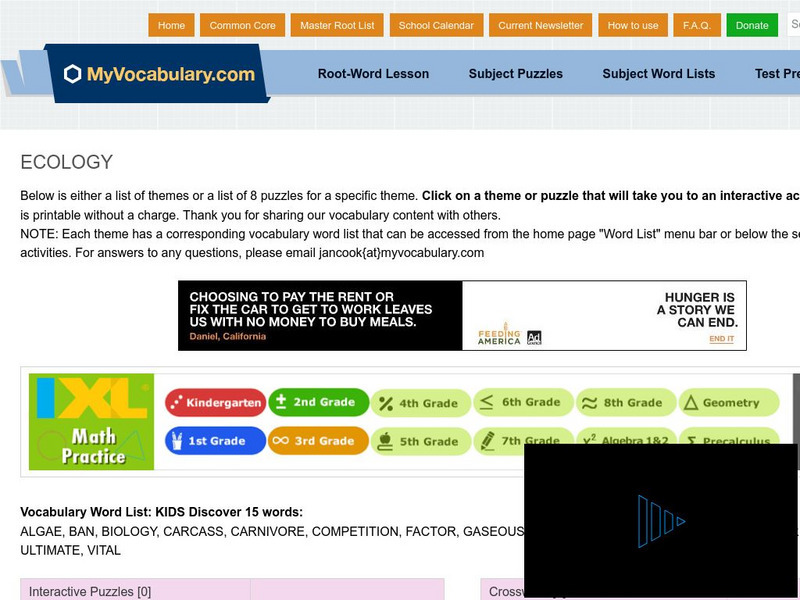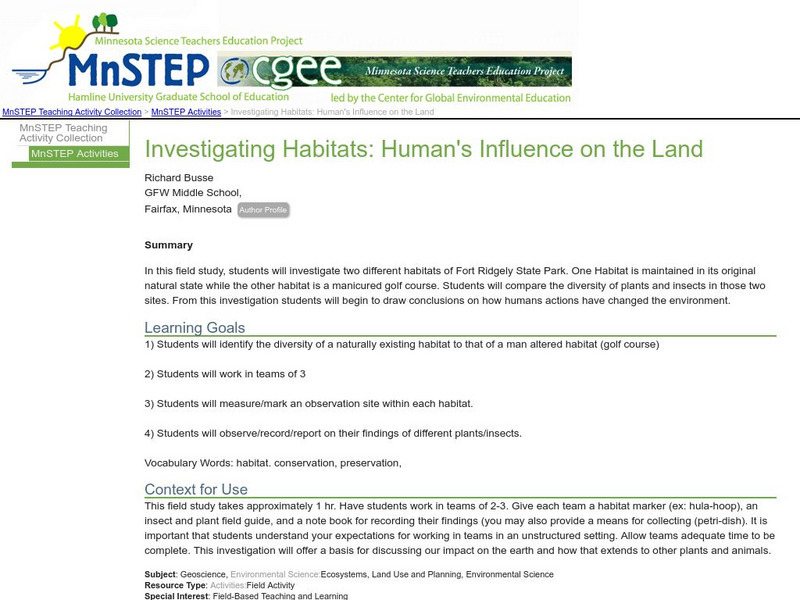Hi, what do you want to do?
Curated OER
Listening to the Prairie
Students, in groups, visit an exhibit and for a prairie scavenger hunt to locate sunflowers and name products made from them. After sketching a prairie dog, they find nature cues farmers use when growing plants and raising animals. The...
Curated OER
Mineralogy, Astronomy, & Ancient Wisdom
Students complete a variety of activities surrounding minerals, crystals, and mineralogy. They locate common minerals on a world map, complete a lab in which they identify the chemical and physical properties of various minerals, etc.
Curated OER
The Importance of Water
Students explore the importance of water. They discuss why water is important and students design an experiment that evaluates the water quality and methods of improving water quality. Students perform testing and report their findings.
Curated OER
The Use of Biocards for Topical Review
Students create biocards to represent vocabulary from their biology course. They review and reinforce their basic knowledge of terminology, structures, or concepts. They create the cards to test themselves or classmates.
Curated OER
"Approaching Walden: From Emerson to Thoreau"
Learners examine selected local leaves in greater detail in the classroom by using more analytical drawing techniques. They use Thoreau's drawing of a Scarlett Oak as their model. Students choose a leave from a box of leaves removed...
Curated OER
How Do We Forecast Weather?
Third graders investigate how scientists collect weather data in order to forecast the weather. They work in small groups in order to research one type of weather technology such as, satellite images, radar, surface observations, or...
Curated OER
What is Migration
Students conduct individual research and participate in discussion be able to identify difference between forced and voluntary migration. They identify if push and pull factors are caused by political, social, economic, or environmental...
Curated OER
Student Peer Review Through a Discussion Board to Develop an Invasive Species Paper
Students develop electronic communication skills through a discussion board while peer reviewing a paper on invasive species. Students work in groups of three to provide constructive feedback on a classmate's paper.
Curated OER
Who Can Harvest A Walleye?
Seventh graders investigate the concept of how an ecosystem is put together while conducting research using a variety of resources. They correctly differentiate between a herbivore and carnivore by placing them in the order of hierarchy...
Curated OER
The Basics:Life Science
Students explore concepts in life science using segments drawn from Discovery Channel. In this life science lesson plan, students participate in discussions about the food chain. Students create a poster to illustrate a...
Curated OER
Seafood: For the Love of Fish
Students role play a scenario specific to decision making in seafood management and conservation. In this marine science lesson, students estimate seafood consumption in their state. They recommend new regulations for better fishery...
Curated OER
Welcome to Populations!
Students define what population is in their own words. For this biology lesson, students explain different ways to measure population density. They interpret population graphs.
Other
Human Ecology and Human Adaptability
Describes eccrine and apocrine glands and relates them to heat tolerance. Also includes some information on sebaceous glands.
Other
Alaska Sea Grant: Investigation 4 Human Impact Survey
Students examine and record data about the impact human activity has on a local aquatic environment in this teaching unit. They then analyze the information and develop a plan for improvement. The unit depends on being able to take the...
Other
Study of Northern Virgina Ecology: Black Carpenter Ant
Lots of information about the black carpenter ant. Learn about their physical characteristics, colonies, life cycle, food sources, and predators. A detailed chart listing many plants and animals permits exploration of their relationships...
Other
Few: Human Impact on the Environment & Environmental Impact on Humans
Human beings have an enormous impact on the natural environment, and ultimately on each other. The way we chose to house, clothe, shelter, and meet the needs for vital resources such as food, energy, and water, not only affect the...
Vocabulary University
My vocabulary.com: Ecology
This page offers a variety of vocabulary puzzles and activities using 15 vocabulary words pertaining to ecology. It also offers an extensive vocabulary word list for Green Conservation and a list of ways humans can protect the environment.
American Institute of Biological Sciences
Action Bioscience: Ecology and Economics
Natural systems studied by ecologists and human systems studied by economists must work together to ensure a future of biodiversity. This interview identifies the needs for both and ways in which the two can balance conservation with...
Science Education Resource Center at Carleton College
Serc: Ecology/geography Classification
This outdoor lesson helps middle schoolers better understand ecological and geographical classifications by teaching it simultaneously in science and geography class. Presenting the two classifications together will help reinforce the...
Pennsylvania State University
Virtual Nature Trail at Penn State New Kensington: Ecological Succession
Explains what ecological succession is and why it happens. Describes some examples, how it affects humans, and why it does not really stop.
Soft Schools
Soft Schools: Biodiversity Quiz (Ecological Problems)
Take an interactive quiz over ecological problems affecting the environment. After completing the quiz, check your score, and then revisit any incorrect question for further review.
National Center for Ecological Analysis and Synthesis, University of California Santa Barbara
University of California: A Global Map of Human Impacts to Marine Ecosystems
Maps in different categories such as fishing, climate change, and pollution were pulled together into a composite map that shows the impact of humans on the world's oceans. Analysis at the time (2008) showed that 40% of the world's...
Science Education Resource Center at Carleton College
Serc: Investigating Habitats: Human's Influence on the Land
Students will investigate two different habitats; one habitat is maintained in its original natural state while the other habitat is a manicured golf course. Students will identify and compare the diversity of plants and insects in those...
Encyclopedia of Earth
Encyclopedia of Earth: Botany: Mangrove Ecology
Extensive article on mangroves. Covers classification, physical characteristics, life cycle, habitat, economic value, and natural and human threats to their survival.



























